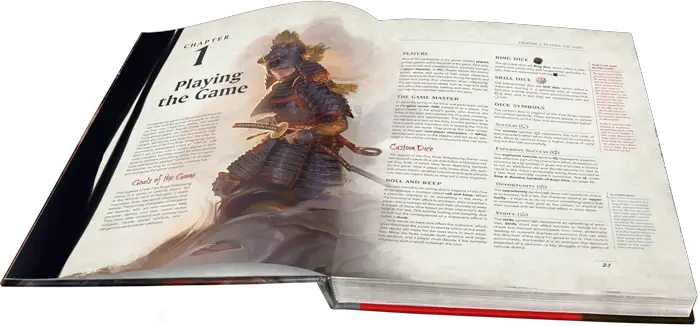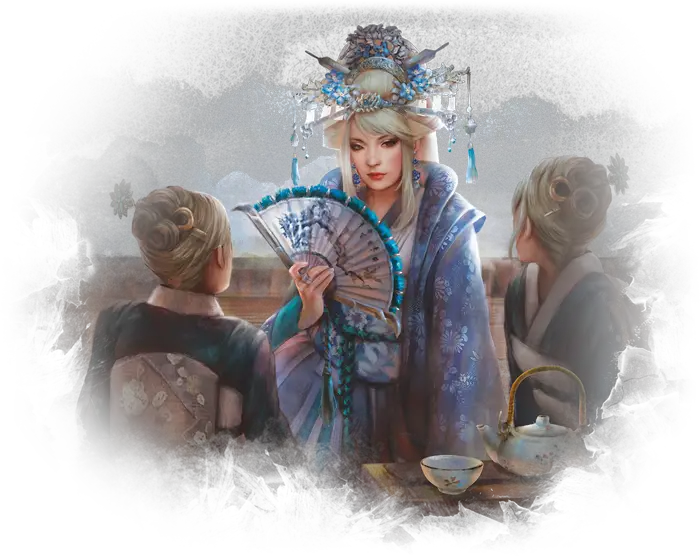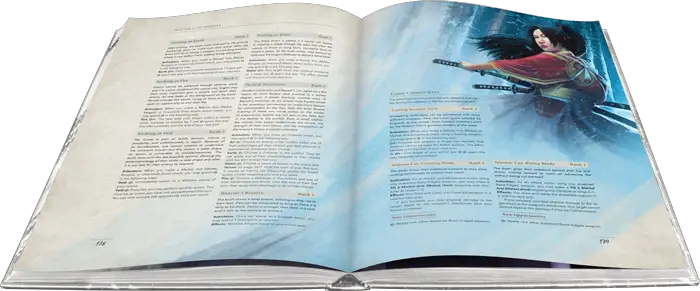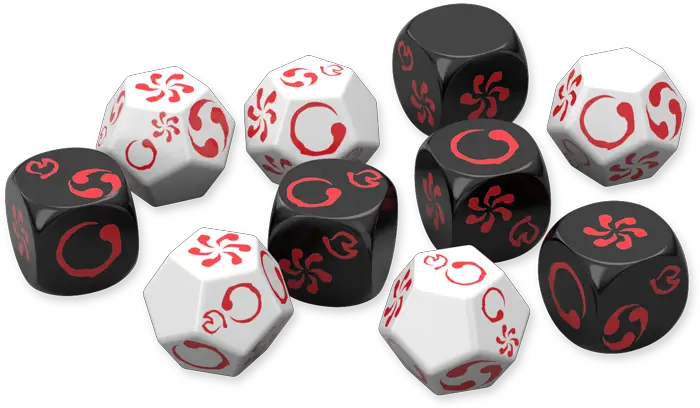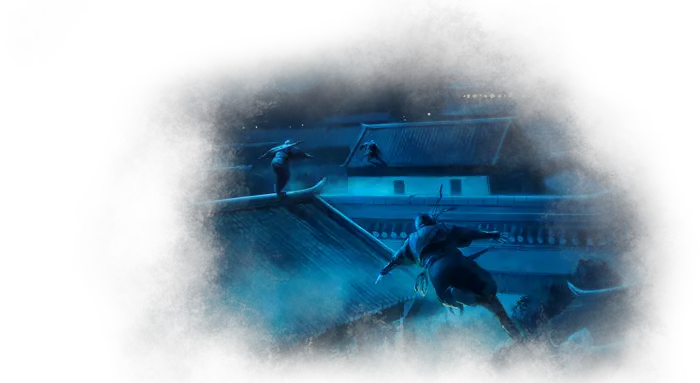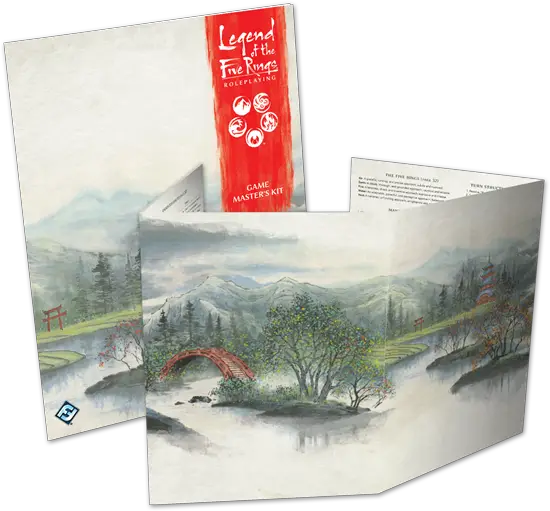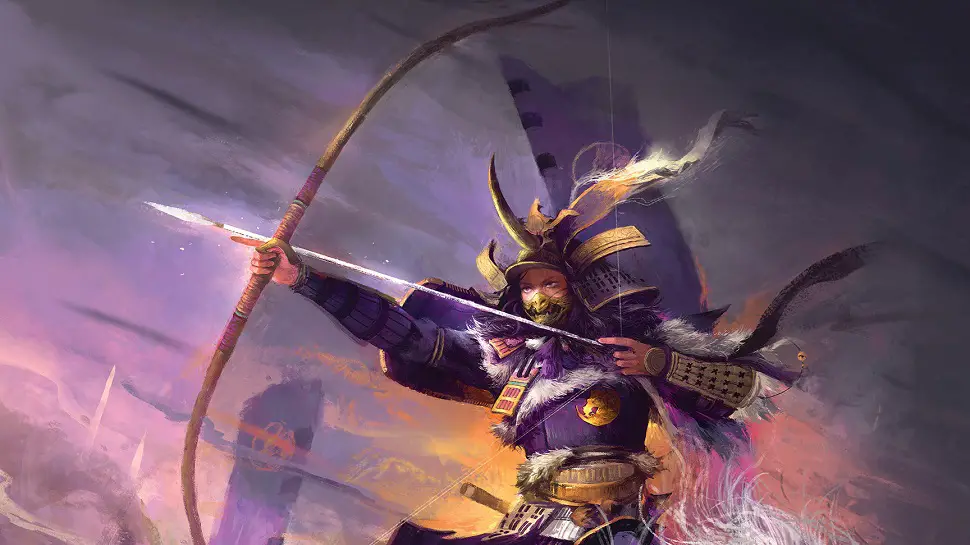
Legend of the Five Rings is set in the fictional world of Rokugan, which draws heavily upon feudal Japan, and the mythology of the oriental world. It is a place of honor, duty, and discipline, where showing even the slightest indication of disrespect can be more dangerous than fighting on a battlefield, and something as small as revealing one’s emotions is considered taboo. But it is also a world filled with magic, ancient evil, vast, unexplored expanses yet to be conquered. In this world, you’ll play a samurai pledged to one lord or another and bound to carry out that person’s will. You might be a mighty bushi wielding a katana and draped in heavy armor, a savvy courtier who excels in the arena of courtly etiquette, a mystical shugenja who calls upon mystical spirits to aid you, or a meditative monk seeking inner peace. And you’ll be forced to fulfill the impossible role of perfect paragon of righteousness, compassion, and duty, even when it goes against your own personal desire.
Like a lot of RPGs, Legend of the Five Rings is about overcoming conflict, exploring a fantastical world filled with adventure, and growing stronger through adversity. What makes it unique, though, is in how it sets itself up for intense personal drama that is the hallmark of any good samurai film. Your character’s role as a samurai and duty to your lord will be at odds with her personal desires and sense of justice, forcing you to choose between your unbreakable oaths and what you believe is honorable. And this internal conflict is at the center of what makes Legends of the Five Rings one of the most unique, story-driven RPGs I’ve ever seen.
Today we’ll be taking a look at the core rulebook, the most essential component for playing the RPG, and the game master’s kit, a small packet of materials aimed at making the GM’s life a little easier. The core rulebook is a robust, beautifully illustrated manual containing 336 pages of rules, lore, and tools to help a group play the game. There’s a lot to cover here, so I’ll break it down by chapter.
Chapter 1: Playing The Game
After a brief introduction describing the world of Rokugan, you’ll be introduced to the primary mechanics of the game. The game utilizes custom dice and a “roll and keep” system where the player chooses to keep or discard the pool’s results in order to get the most desirable outcome. The custom dice contain four unique symbols: success, explosive success, opportunity, and strife — none of which are negative effects or results that cause you to fail. Rather, the goal is to reach the number of success required to accomplish the task you’re trying to accomplish by keeping the most beneficial results and discarding the rest. Success helps you succeed at most skill checks, explosive success is worth one success and gives you the chance to add another die to your pool, opportunity gives you the chance to activate certain talents and affect story details, and strife represents emotion accumulating in your character, whether it be positive or negative emotion, which may require your character to become compromised by an overflowing of their emotions on a long enough timeline.
This core system that governs most of the action in Legend of the Five Rings is a blend of traditional success-or-failure systems, and a more narrative-focused dice system whereby the results determine story details and impact your character’s emotional state. One of the downsides here is that resolving dice results can take a great deal more time than adding up a couple numbers and delivering a binary verdict. It certainly doesn’t help that the unique symbols on the dice are similar in appearance, which adds an extra unnecessary layer to the difficulty it takes to learn the new system. And now one must consider the emotional impact of actions on one character, the narrative results of each check, in addition to whether or not they succeeded in their goal. But while the process of resolving a single dice roll can take a few minutes, it is also far more rewarding, nuanced, and dramatic than doing addition. It might not be for everyone, but for groups interested in dramatic storytelling, it’s very well designed and fits perfectly into the high stakes and high drama of a samurai’s life.
Another way in which Legend of the Five Rings is unique is in how your character’s attributes are determined. Instead of having a score for strength and intelligence and so on, during character creation you’ll be assigned a value of 1-5 on each of the five elements that govern Rokugan: earth, fire, water, air, and void. Each of these represents a different philosophy of doing things, rather than a specific attribute of one’s person. Earth represents an approach of thoroughness, patience, and caution. Fire represents doing things with directness, ferocity, and explosiveness. Water represents an adaptive, perceptive, and elegant approach. Air represents doing things with grace, cunning, and subtlety. Finally, void represents a wise, unflinching, and balanced way of doing things.
Combined with one’s skills, the five rings are the basis of any check the character will make during the course of gameplay, which forced the GM and the players to completely rethink what they know about governing attributes and assembling dice pools. For example, if a character is trying to leap across a gap, they may be able to use multiple different rings as their governing attribute to do so, but depending on the circumstances not all of those options would be wise. If they had unlimited time and were under no pressure to cross the gap, a character with a high earth ring might decide to stop and consider the best way across and make a check using that ring. However, if that same character were being chased by a dangerous enemy, they wouldn’t have time to utilize that ring, and might be forced to make use of their less impressive fire ring, which throws caution to the wind in favor of speed.
Another component of gameplay that sets itself apart from other RPGs is the ruleset for becoming “compromised,” which is a status your character enters when the life of presenting oneself as a stoic, emotionless samurai who is beyond the emotions of normal men becomes too burdensome for one to handle. When your character is compromised, the guise of purity starts to tear, which can have enormous consequences in a society that demands perfection. Over time, being compromised can have an adverse effect on your honor, glory, and status (scored attributes meant to gauge one’s success as a samurai), and cause their ninjo (i.e. one’s human feelings) compromise their giri (i.e. one’s sworn duty). In order to rid oneself of the effect, you can take a long path towards recentering yourself and regaining control of oneself through sheer discipline, or get rid of the status immediately through “unmasking,” which is the act of removing the samurai facade altogether for a limited amount of time and doing something drastic, which can have massive implications on the narrative. This battle between giri and ninjo is at the heart of everything in Legend of the Five Rings, and sets up a ton of fodder for the GM to use to create high stakes and dramatic circumstances that make for incredibly compelling tabletop gaming.
Everything in Legend of the Five Rings is built around creating the ultimate samurai experience, and the first chapter of the core rulebook makes that crystal clear by scrapping everything you learned from your power fantasy D&D days, and presenting something you’ve never seen before. While that undoubtedly creates a formidable learning curve for even the most veteran RPG players, it’s a necessary component to faithfully channel the essence of your favorite Japanese samurai flicks. As someone who prefers RPGs that break the mold and steer towards story-first roleplaying as opposed to combat-focused power fantasy, Legend of the Five Rings is right up my alley, and one of the best executions of a narrative focused RPG in recent memory.
Chapter 2: Creating A Character
Instead of choosing a class, buying skills, and some of the other stuff you might expect from character creation in a tabletop RPG, Legend of the Five Rings has you play a game of twenty questions, whereby your character’s starting stats, skills, and personal background are generated from these answers. The first three questions are by far the most consequential, and will determine most of what your character can do and what your playstyle will likely be. The first question is “What clan does your character belong to?” and here you choose from one of seven great clans (with an eighth minor clan available as a free add-on online), which determines some of your starting stats and skills. This first question also determines a lot of your character’s philosophy and views on Bushido. The second question is “What family does your character belong to?” and here the clans are broken into smaller families, each with their own distinctive vibe, which further augments some of your starting stats and skills, and also determines your starting wealth. The third question is “what is your character’s school, and what roles does that school fall into?” and here we really get cooking, by determining one’s fighting techniques, abilities, advancement paths, and even one’s starting outfit.
The amount of options within these first three questions is staggering, giving plenty of diversity to the available leveling paths and easily identifiable roles that players can choose to take on within a party. The options after the first three are mostly freeform questions that develop the personality, and determine some very important narrative questions, chief among them being who the character’s lord is, who they will then be honor-bound to obey above all else. While most of these don’t have mechanical changes to one’s characters, many of them are so vitally important (like choosing one’s giri and ninjo) that they aren’t optional, especially for a game that is so centered around storytelling and emotional conflict.
Beyond the game of twenty questions, players can also choose advantages and disadvantages for their character, which augments some of the mechanics and creates storytelling stakes by adding quirks to your character, which might include their personal passions, distinctions, adversities, and anxieties. There’s a lot to love about this section, as disadvantages can create additional hurdles for characters that are supposed to be flawless samurais, and advantages can grant characters unique boons to make their characters a little more formidable.
Chapter 3: Skills
Skills are one of the only parts of Legend of the Five Rings that function in a way that will seem familiar to most roleplayers. Skills are broken into five groups (Artisan, Martial, Scholar, Social and Trade skills), and help players achieve things that they might not be able to accomplish using their ring values alone. Mechanically, having skills is one of the best ways to improve your chances of doing something, adding a more powerful die to your pool that is only available through having skills. Buying skills within those listed on the advancement table for your chosen school also allows you to level up in your chosen skill, which unlocks a variety of perks.
While not especially exciting, skills are an essential component to any RPG and Legend of the Five Rings is no exception. The fact that an entire type of dice is dedicated to rewarding those who purchase them is definitely a nice incentive for players who otherwise ignore them in favor of buying new talents or attribute increases (AKA my entire current RPG group). Rewarding players for purchasing skills listed on their school’s advancement table is also a great way to get players to focus on their roles.
Chapter 4: Techniques
Techniques are special abilities that allow characters to do things they wouldn’t normally be able to do using their base rings or skills. Here you can access unique fighting techniques that can give your bushi the edge on the battlefield, or learn ancient rituals that allow you to release a firestorm of flames from within you. Generally speaking, techniques are only available to those belonging to a school that teaches that ability, with more powerful techniques requiring the player to advance their school ranking to acquire them.
Techniques are the best way to transform your character into a unique kind of badass. While boosting your rings and buying skills will allow you to do mundane things a little easier, techniques give you access to things that only your character is able to do, like infusing your weapon with the power to smite otherworldly beings, or summoning a gust of wind to carry your character through the air. Anyone can master a blade, but only through techniques can one summon a flaming katana out of thin air, and that makes a world of difference. With more than 50 pages of options spread across the available schools, the amount of options available is staggering.
Chapter 5: Equipment
It’s not uncommon for the equipment section of RPGs to get the short end of the stick, and Legend of the Five Rings is no exception. While the selection of weapons is fairly diverse, there are only a handful of options in the way of armor or personal effects. The good news here is that, while other settings might be devastated by a like of equipment offerings, the low-tech, minimalist nature of a samurai setting makes the lack of options here less of an issue. And the most important element here, weapons, has been taken care of. Whether you want to be a barbaric warrior with a tetsubo, or a nimble ninja with a blowgun, the equipment section has something for you. Aside from that, though, you’ll have few things to spend your character’s money on aside from a few generic sets of armor and bottles of sake.
Chapter 6: Scenes and Conflict
This section is dedicated towards teaching the players and GM some of the more in-depth mechanics of Legend of the Five Rings, including combat encounters, which are divided into three types: duels, skirmishes, and mass battles. Duels are one-on-one encounters that focus in on the careful game of chess that takes place between two skilled combatants, while mass battles focus on the bigger picture of encounters fought between two armies. Nested in-between the two are skirmishes, which are your run of the mill party combat encounters.
The rules for each of these combat encounters is different, with encounter-specific options available in each scenario. For example, in a duel your character can use the “predict” action, which allows your character to bait your opponent into a move and win by proving to be the more clever opponent. During mass battles, on the other hand, you can use the “rally” action, which allows your character to regroup the troops and control panic among your forces. In the same vein, there are special rules and actions that govern social encounters and navigating the delicate world of intrigue. The amount of care put into these different scenarios and the various options available are bound to make any player or GM excited at the prospect of playing each of the options available — It’s tabletop RPG mechanics at their best.
Chapter 7/8: The Game Master & Non-Player Characters
Finally, there’s a section directed at the game master. This part of the book is filled with everything a GM would need to run a Legend of the Five Rings campaign. Most of this section is focused on storytelling tips, and as a veteran game master, I would normally thumb through a lot of this without giving it a second thought. But with a game so laser-focused on a specific kind of storytelling, the advice here is actually incredibly helpful. You’ll find tips on using concepts like the tenets of bushido to create stakes in your campaigns, and how one’s honor can come into play during a moral crisis. They even give you options for different kinds of campaigns, like ones where the characters live on the outskirts of society and don’t belong to major or minor clans, and ones where the stakes are increased to have a more epic “save the world” focus, rather than sticking to the smaller-scale personal struggles that is provided as the game’s standard.
This section also contains a vast array of sample NPCs to use or to inspire new creations for your own campaigns, as well as tips for creating NPCs without blowing a few hours by going through the entire character creation process. The amount of options here is pretty substantial. You’ll find everything from peasants, to monsters from the Shadowlands, to wild animals.
This is one of the more useful GM sections I’ve seen in an RPG, and maybe that’s because the game is so unique that it requires a lot of learning and thoughtfulness to run properly. If there’s one thing it’s missing, it’s more specific information on the setting, meaning places your players can go and important people that your players can meet. Annoyingly, a lot of this seems to have been left out intentionally to serve as fodder for future sourcebooks (two of which are already out, with more on the way). It would also be nice if this section included a sample adventure or some modules to be integrated into a larger session, and luckily, that’s where the game master’s kit comes in…
Game Master’s Kit
This $20 add-on is not a mandatory component of playing Legend of the Five Rings, but is invaluable to even the most experienced GM due to the complexity and uniqueness of the RPG in question. It comes with two components: A GM screen, and a 31-page adventure called “Dark Tides,” which takes the characters to the town of Taimana Choryu, in search of an opium-addicted samurai who was last seen there. While the adventure isn’t particularly long, it’s full of twists and turns, and serves as a good entry point for newcomers looking to dive into the mysterious, magical world of Rokugan. As an added bonus, Dark Tides integrates with one of the adventure modules available for purchase separately (Mask of the Oni), which can serve as a follow-up for groups who complete Dark Tides.
The GM screen is one of the more beautiful ones I’ve seen, with the outside featuring beautiful painted landscapes including courtyards with cherry blossom trees and snowy mountain peaks. Per usual, the inside has all the grids, tables, and references you’d need to run a game with minimal interruption caused by flipping through the book to find a rule you haven’t memorized yet. For forgetful and impatient GMs like myself, this is an essential piece of the puzzle.
The one component that’s oddly missing from this package, is any kind of map of the world of Rokugan. After a little research I’ve discovered that if you want a full-size map of Rokugan, you’ll need to purchase the Legend of the Five Rings Beginner Game, which is quite an ask for those who don’t want anything from that package aside from the map.
Legend of the Five Rings
Excellent
Legend of the Five Rings is a masterpiece in story-first tabletop gaming. It’s been built from the ground up to serve as the ultimate samurai RPG experience and accomplishes that goal with startling success. If you care at all about narrative-focused roleplaying, I cannot recommend this game more highly.
Pros
- The ultimate samurai RPG, with mechanics designed to support storytelling
- Tons of diverse character options
- Incredibly stylistic rulebook with great art and overall presentation
Cons
- Unique mechanics can be hard to learn, especially with confusing dice symbols
- You’ll need to buy sourcebooks for in-depth setting information
- Game Master’s Kit lacks a map

